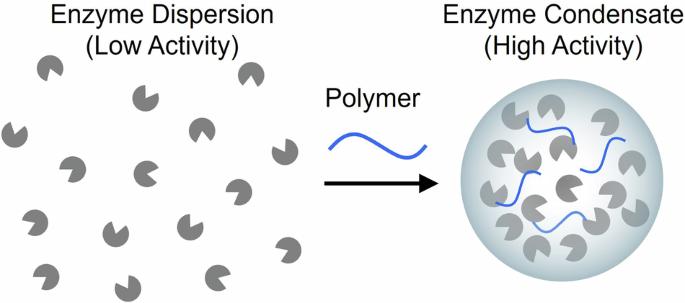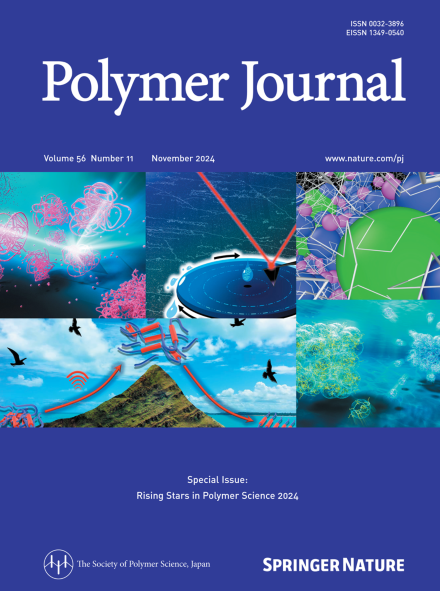Polymer-engineered condensates for enzyme activation
IF 2.7
4区 化学
Q3 POLYMER SCIENCE
引用次数: 0
Abstract
Enzyme condensates are powerful tools for controlling enzymatic reactions in living cells. Recent advances in polymer science have enabled the design of artificial enzyme condensates in vitro, providing a promising approach to enhance enzymatic activity and stability for various biotechnological applications. In this review, we describe a systematic approach to engineering enzyme condensates through polymer-based strategies. First, we consider the design principles for tailoring the state of the enzyme condensates using charged polymers, including approaches that utilize enzymes as scaffolds or clients, and compare these condensates with other enzyme activation methods, highlighting the advantages and potential limitations of enzyme condensates. Second, we review the major factors that affect enzyme performance within the condensates, including size-dependent effects and local environmental changes. These data are supported by recent mechanistic studies using various enzyme systems, including oxidoreductases. Finally, we focus on possible applications and outline the key challenges in expanding the utility of enzyme condensates from single-enzyme to multienzyme systems and from solution-based to surface-bound architectures. Our comprehensive overview of enzyme condensate engineering provides a new perspective to bridge cellular organization principles and innovations in enzyme catalysis. This review highlights recent advances in engineering artificial enzyme condensates in vitro using charged polymers. Based on our recent findings, we describe strategies for designing condensates through interactions between polymers and enzymes or coenzymes. We then summarize enzyme activation mechanisms triggered by enzyme condensates, including size-dependent effects and conformational changes in enzymes. We also discuss potential applications and future directions, including multienzyme systems, integration with solid surfaces, and combination with rational enzyme design.

用于酶活化的聚合物工程凝聚物
酶凝聚物是控制活细胞中酶反应的有力工具。聚合物科学的最新进展使体外人工酶凝聚物的设计成为可能,为各种生物技术应用提供了提高酶活性和稳定性的有前途的方法。在这篇综述中,我们描述了一种系统的方法,通过聚合物为基础的策略工程酶凝聚物。首先,我们考虑了使用带电聚合物来调整酶凝聚物状态的设计原则,包括利用酶作为支架或客户端的方法,并将这些凝聚物与其他酶激活方法进行比较,突出了酶凝聚物的优势和潜在的局限性。其次,我们回顾了影响凝聚物中酶性能的主要因素,包括尺寸依赖效应和局部环境变化。这些数据得到了最近使用各种酶系统(包括氧化还原酶)进行的机制研究的支持。最后,我们将重点放在可能的应用上,并概述了将酶凝聚物从单酶系统扩展到多酶系统以及从基于溶液的结构扩展到表面结合结构的关键挑战。我们对酶凝聚工程的全面概述为连接细胞组织原理和酶催化创新提供了新的视角。本文综述了近年来利用带电聚合物制备人工酶缩合物的研究进展。基于我们最近的发现,我们描述了通过聚合物和酶或辅酶之间的相互作用来设计凝聚物的策略。然后,我们总结了酶凝聚物引发的酶激活机制,包括酶的大小依赖效应和构象变化。我们还讨论了多酶系统、与固体表面结合以及与合理酶设计相结合的潜在应用和未来发展方向。
本文章由计算机程序翻译,如有差异,请以英文原文为准。
求助全文
约1分钟内获得全文
求助全文
来源期刊

Polymer Journal
化学-高分子科学
CiteScore
5.60
自引率
7.10%
发文量
131
审稿时长
2.5 months
期刊介绍:
Polymer Journal promotes research from all aspects of polymer science from anywhere in the world and aims to provide an integrated platform for scientific communication that assists the advancement of polymer science and related fields. The journal publishes Original Articles, Notes, Short Communications and Reviews.
Subject areas and topics of particular interest within the journal''s scope include, but are not limited to, those listed below:
Polymer synthesis and reactions
Polymer structures
Physical properties of polymers
Polymer surface and interfaces
Functional polymers
Supramolecular polymers
Self-assembled materials
Biopolymers and bio-related polymer materials
Polymer engineering.
 求助内容:
求助内容: 应助结果提醒方式:
应助结果提醒方式:


